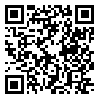Volume 16, Issue 1 (2016)
QJER 2016, 16(1): 73-94 |
Back to browse issues page
Download citation:
BibTeX | RIS | EndNote | Medlars | ProCite | Reference Manager | RefWorks
Send citation to:



BibTeX | RIS | EndNote | Medlars | ProCite | Reference Manager | RefWorks
Send citation to:
Lotfalipour M R, Bazargan B. The Study of Real Effective Exchange Rate, Export and Import Changes on Trade Balance in Iran. QJER 2016; 16 (1) :73-94
URL: http://ecor.modares.ac.ir/article-18-9068-en.html
URL: http://ecor.modares.ac.ir/article-18-9068-en.html
1- Professor of Economics, Ferdowsi University of Mashhad
2- M.A. Student of Economics, Ferdowsi University of Mashhad
2- M.A. Student of Economics, Ferdowsi University of Mashhad
Abstract: (12499 Views)
Trade balance is regarded as both main macroeconomic factor and strategic constraint in developing countries. Exchange rate, which is defined as parity relationship between national currency and foreign currencies, is a vital determinant of countries’ trade balance. As the real effective exchange rate measures the changes in prices and relative costs by a common currency, it is the most popular indicator to measure competitiveness.
On one hand, fluctuation of this index represents disequilibrium in the economy, and on the other hand, it is the cause of more instability. Since the direction and size of the effects of real exchange rate on trade balance is an important macroeconomic issue, this articleinvestigates the real effective exchange rate changes on trade balance in Iran and its’ major partners using the Vector Error Correction Model ( VECM ) over the period 1993-2011. The results indicate that the real effective exchange rate volatility reduces trade balance only for Germany in the short run and rises it for Italy in the long run.
Article Type: Research Paper |
Subject:
E49 - Other
Received: 2013/12/29 | Accepted: 2014/06/18 | Published: 2016/05/21
Received: 2013/12/29 | Accepted: 2014/06/18 | Published: 2016/05/21
| Rights and permissions | |
 |
This work is licensed under a Creative Commons Attribution-NonCommercial 4.0 International License. |







